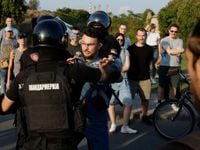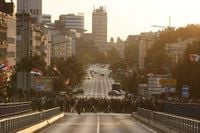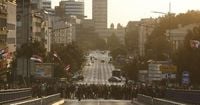On Saturday, September 13, 2025, the streets of Serbia were transformed into a vivid portrait of division and unrest, as anti-government protesters and supporters of President Aleksandar Vucic staged parallel rallies across the country. The day’s events—peaceful in most places, tense in others—were the latest chapter in a political crisis that has gripped the Balkan nation for more than ten months, sparked by tragedy and fueled by accusations of corruption, repression, and a battle for the soul of Serbia.
The origins of the current unrest trace back to November 2024, when a concrete canopy collapsed at a newly renovated train station in the northern city of Novi Sad, killing 16 people. According to AP and Newsday, the disaster ignited public fury and a nationwide movement demanding justice for the victims. Many blamed what they saw as corruption-fueled negligence for the tragedy, and the initial calls for accountability quickly evolved into a broader challenge to Vucic’s populist government.
What began as student-led protests seeking answers soon swelled into a mass movement. Over the past months, hundreds of thousands have taken to the streets, their demands expanding from justice for Novi Sad’s victims to calls for President Vucic’s resignation and sweeping political change. The government, however, has proven unwilling to yield. Vucic’s Serbian Progressive Party, once content to ignore the demonstrations, recently began organizing its own counter-rallies, hoping to project strength and rally its base. The result has been a country split into two camps—each convinced of its cause, each unwilling to back down.
Saturday’s rallies, reported by AP, Al Jazeera, and Newsday, unfolded in cities and towns throughout Serbia. Police, anticipating trouble, separated the opposing groups in most locations. In Novi Sad, officers blocked bridges and streets to keep the camps apart, while in Belgrade—the capital and epicenter of the unrest—riot police stood ready as President Vucic himself joined his supporters for a show of confidence. Brief scuffles erupted when officers pushed away anti-government demonstrators, but no major incidents were reported.
President Vucic, addressing his supporters, struck a defiant tone. "People want to live normally, they don’t want to be harassed and want to be free," he declared, according to AP and Newsday. He has consistently refused student demands for an early parliamentary election, opting instead to tighten the government’s grip. Over the past weeks, the crackdown has only intensified: more than 100 university professors have been dismissed—many replaced by Vucic loyalists—and police have faced mounting accusations of brutality against peaceful demonstrators.
For protesters, the government’s response has been both a rallying cry and a source of fear. Nikolina Sindjelic, a student arrested during August’s protests, spoke out about her experience in detention. “They beat us because they are afraid of us,” she told the crowd outside a police unit headquarters, as reported by Al Jazeera. “They have hit us and they will hit us because they know it is all over [for them].” Such claims have only deepened concerns about human rights and the rule of law in Serbia.
The government, for its part, has painted the protest movement in starkly different colors. President Vucic has repeatedly accused student-led demonstrators of being “terrorists” acting under Western orders—though, as noted by AP and Newsday, he has offered no evidence to support these claims. This rhetoric, critics argue, is designed to delegitimize dissent and paint the opposition as traitorous rather than patriotic.
International observers have not been silent. European Commissioner for Enlargement Marta Kos, speaking during a trip to Austria on September 8, 2025, addressed the growing unrest. “We have a problem in Belgrade,” she said, according to Al Jazeera. “The people have the right to protest. The severe violence on the streets of Serbia, the many acts of vandalism, must stop. We expect the police to act appropriately and respect fundamental rights.” Her comments reflect growing concern in Brussels and other European capitals about the trajectory of Serbian democracy and the government’s handling of dissent.
Despite the mounting pressure—both at home and abroad—President Vucic has shown little sign of softening his stance. The Serbian Progressive Party’s counter-rallies, organized in response to the persistent student-led protests, are intended to demonstrate that the president retains a strong base of support. Yet, the sheer scale of the anti-government demonstrations, which have drawn crowds into the hundreds of thousands, suggests a society deeply divided and a leader facing the most serious challenge of his tenure.
For many Serbians, the stakes are high and the future uncertain. The memory of the Novi Sad tragedy remains fresh, a symbol of both loss and the dangerous consequences of unchecked power. The government’s refusal to call early elections, the dismissal of professors, the accusations of police brutality—all have fueled a sense of injustice and urgency among the opposition. At the same time, Vucic’s supporters argue that stability and order are paramount, and that the protests threaten to undermine hard-won gains and open the door to foreign interference.
The situation has left Serbia at a crossroads. On one side stand those demanding accountability, transparency, and democratic renewal; on the other, those who see Vucic as a bulwark against chaos and external meddling. The police, tasked with keeping the peace, have found themselves accused of both excessive force and insufficient control, their actions scrutinized by domestic and international audiences alike.
As the rallies ended on Saturday, there was little sense that either side had gained the upper hand. The government’s show of strength was met with continued defiance from the opposition, and the presence of riot police underscored the volatility of the moment. For now, Serbia’s deep political crisis shows no sign of resolution.
With each passing week, the country’s divisions seem to harden, and the memory of the Novi Sad tragedy remains a powerful catalyst for change—or, depending on one’s perspective, a rallying point for those determined to hold the line. The coming months will test the resilience of Serbia’s institutions, the patience of its people, and the willingness of its leaders to find a path forward that honors both justice and stability.



